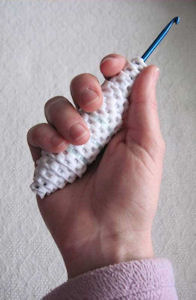|
|
In the last issue, I wrote about gripping your hook and that certain hooks are easier on your hands. This issue, I would like to show you an easy method to modify a favorite hook to be more hand-friendly.
The first thing to consider is how permanent a modification you want to make. Sometimes you want a temporary change that doesn’t damage or permanently alter the hook. An example would be the antique steel hooks you inherited from your great grandmother. You want to use them, but those teeny tiny handles can be very hard to grip without some alteration. The second thing to consider is how you want to hold the hook you are modifying. Modifications for a knife hold can be quite different from those made for a pencil hold. And there are all sorts of variations on those holds. |
|
 |
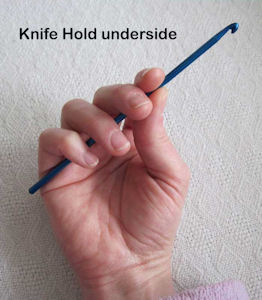 |
|
 |
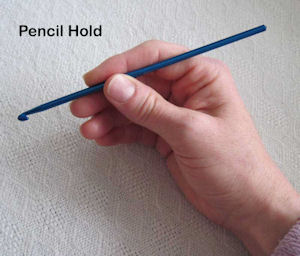 |
|
| Thirdly, think about what type of discomfort you are having when crocheting with the hook. Does the hook rub your thumb or palm? Do you get blisters when crocheting, and where are those blisters?
Finally, if you have tried other comfort hooks that are commercially available, think about what you liked and disliked about them. Many of the commercial comfort or ergonomic hooks are quite expensive so trying some modifications on inexpensive hooks to see what you like before buying a commercially modified hoot is helpful as well. |
||
 |
My favorite way to temporarily modify a hook handle is to use Shelf Liner Cushion. This material can be used to create any shape of hook handle modification you could want. It is very affordable, easy to use and light weight. Plus it can be removed or undone without harm to your hooks. I will show you this method in the following series of photographs.
You will need a roll of shelf liner, small hair elastics or rubber bands, and, of course, a crochet hook. You will also need scissors, a permanent marker, and a ruler if you don’t feel comfortable just jumping in with the scissors. In my sample I purchased a roll of shelf liner at a local drugstore for a few dollars. My roll was 12 inches wide and 4 feet long (30.5 cm x 1.2 m). The fabric is cushy with holes and has a slight sticky cling to it without any adhesives. It is easy to cut with regular scissors. |
|
| Using shelf liner cushion to modify your hook handles is simply a matter of cutting pieces the size you want, rolling them up snugly around the hook, and securing with either the rubber bands or elastic. Because you can undo and redo the rolls as needed, it is easy to make adjustments in order to have the handle that is just right for you. If you wish, you can mark the size of the hook on the outside of the cushion with the permanent marker. |  |
Use the hook to measure how wide a piece of shelf liner to cut off. In my example I am using a size G 4.00 mm Boye hook. I find the thumb rest with the texture on it to be irritating to my hand, so I want to cover that. I also want to cover the end of the hook handle. |
| For folks with larger hands than mine you might want to cut the liner even wider to extend the length of your hook. | ||
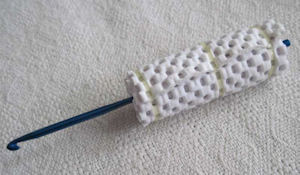 |
 |
|
| The simplest way to use the shelf liner is a straight roll to build up the amount of layers you want for your handle. A 12” by 4 ¼” strip cut off the end will make the full roll. A shorter strip 2 1/2” by 4 ¼” will make the narrow roll. Generally, a narrow cushion on the handle is better for those that use a pencil hold, whereas the full roll is more comfortable for knife holders. | 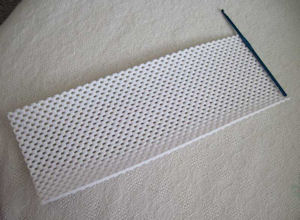 |
|
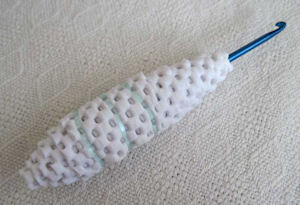 |
My favorite style of rolled shelf liner handle modification is what I call tapered. This style is great for all types of holds; if you want to switch holds while working on your project you don’t have to switch hooks. | |
| The tapered style of roll takes a bit more planning and some experimenting. I again started with a strip 12” x 4 ¼”. Then I cut triangle shapes off the long sides as seen in this photo: The long edge that will be nearest the hook end has a deeper triangle; the edge that will be at the end of the hook is shallower to make a somewhat rounded end to the handle. |
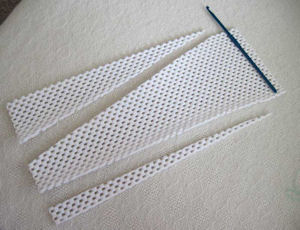 |
|
|
|
Once you have secured the loose end of the roll with bands you can try it out and see if it needs further adjustment.
|
|
| You can use all kinds of inexpensive crafting materials and household supplies to make your own DIY Hook modifications. Any material that can be molded to a permanent non-shrinking shape can be used. Materials that can be cut to shape and wrapped around the handle can also be used. Some additional ideas are: | ||
| Polymer Clay – this is a great material for making a permanent handle for your hook. The disadvantages are that you have to modify each and every hook, and if you use it on a very small diameter hook (like I did in my sample photo), it can make for a fairly heavy hook.
Paper Clay or Papier-Mache’ – these are lighter-weight materials and can be semi-permanent, depending on the material of the crochet hook you are modifying. Both Paper Clay or Papier-Mache’ can be used over an aluminum foil base for a very light weight hook. The disadvantages to these materials are: again you have to modify each and every hook, and some of the materials available can be a bit fragile. Coating the finished result with some sort of sealant can help with that. Felt can make a great handle for your hook, particularly if you crochet the fabric and felt it on to the handle. This type of modification is rarely permanent and can often be switched amongst the hooks in your work basket. One disadvantage is that you may have difficulties with the hook sliding out of the handle while you are working unless you glue the hook into the felt. However, gluing would eliminate the ability to use the handle with more than one hook. |
 |
|
 |
If making your own modifiers is not working for you, there are some commercially available options for some of the more common sizes of crochet hooks.
Susan Bates Comfort Cushion – These are generally available at many craft and hobby stores. They come in a couple of different sizes. It is said to be removable so you can use one cushion with a number of hooks. I put mine on a size G Boye hook I had years ago, and have never been able to get it off again. You may find you get a different result if you used the comfort cushion with a Bates hook, or with smaller diameter hooks. Professional Tool Handle Cushions – These handle cushions are available from construction supply companies, and are used to reduce heat transfer and vibration issues. They are often a good size for using on crochet hooks. I’ve not tried them personally yet, but have heard good things about them from other crocheters. This is a link to a supplier’s site online – McMaster-Carr. You might also be able to find them at your hardware or local DIY store. |
|




